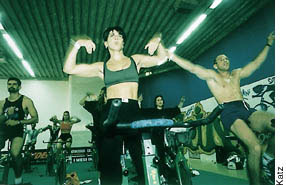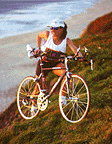|
By Gregg Cross
Are your workouts becoming more of a burden than an enjoyment? Do you peel yourself out of bed every morning and
force yourself to train? Have you found the following question has been sneaking into your brain, mid-workout?
"Why am I doing this?"
Don't despair, there's still hope. You just need to grab yourself some goals.
A couple of weeks back, I began a new coaching position for a high school swim team that's known around the area
as the 'Bad News Bears' of high school swimming. The team's not very good and it loses so many swimmers, our pool
should be declared an annex of the Bermuda Triangle.
A couple days after taking over the program, a local newspaper reporter was interviewing me. When she asked, "why
has it been so hard to develop a swimming program at this school?" I said, "watch this." As the
swimmers were warming up, I stopped several of them individually and asked them a simple question:
"Why are you swimming this season?"
The first four swimmers looked at me through their fogged goggles like I was nuts. The best answer I could get
was a squeamish, "I want to be on the team." Finally, one responded by saying, "I want to qualify
for the state championships and place in the top three." Not coincidentally, she is my hardest-working athlete.
Goals are not only the key to success, but they also compose the stepping-stones to success. So, where do you start?
The Goal
Step one is setting your goal and making it a part of your everyday life. Last year, I made it a goal to swim around
Key West; 12.5 miles in the shark-infested Gulf of Mexico. If I had just decided to keep this goal to myself, I'd
have chickened out within a couple months. Instead, I told everybody who would listen: my swimmers, my wife, my
co-workers and my son. I created a situation where it would have been harder to back out of my commitment that
it was to actually go through with it.
Whether it's your first Ironman, a P.R. for a 5K run, or a swim around Key West - you need to make a commitment.
For me, choosing goals that I'm not even sure are achievable is the route that works the best. The goal has to
be a challenge to be worthwhile, but not so daring that it falls outside the realm of possibility. Achievable goals
combined with a personal challenge and even the fear of failure brings life and meaning to your training.
Just a thought! I'm putting this next article in just to give you all something to think about,
or as Arsinio Hall would say, it's something that makes you say "hmmmmm"
Skip the warm-up

Don't bother with the stretches . . . you'll pull a muscle anyway
STRETCHING before you exercise in a bid to prevent injuries is a waste of time. So say Australian researchers who
have advised the country's army to consign the tradition to the scrap heap.
Army physiotherapist Rod Pope, working with colleagues at the University of Sydney and Charles Sturt University
in Wagga Wagga, has monitored more than 2600 army recruits over a year in randomised, controlled trials. Some of
the recruits stretched particular leg muscles before exercise; others did not. Yet there were no differences in
injury rates between the two groups--and not just because too few recruits in either group became injured to register
a significant effect. "We were able to rule out even a quite small effect of stretching," says Pope.
"This has not been properly researched before," he explains. "Stretching was assumed to work in
preventing injury, but there was no evidence to suggest it did."
The work has been accepted for publication by Medicine and Science in Sports and Exercise, the journal of the American
College of Sports Medicine. "We are telling the army to no longer stretch," says Pope. "But it's
a long tradition and tradition dies hard."
Despite this advice, Pope stresses that it is important to stretch muscles which are tight and could restrict the
normal range of movement. He also suspects that stretching after exercise could be beneficial--although this has
not been fully investigated. "There is no evidence that points unequivocally one way or the other," says
Robert Price of Deakin University in Melbourne.
Julia Hinde, Melbourne
From New Scientist, 18 December 1999
|
|
